Bhushan B. Nanotribology and Nanomechanics: An Introduction
Подождите немного. Документ загружается.

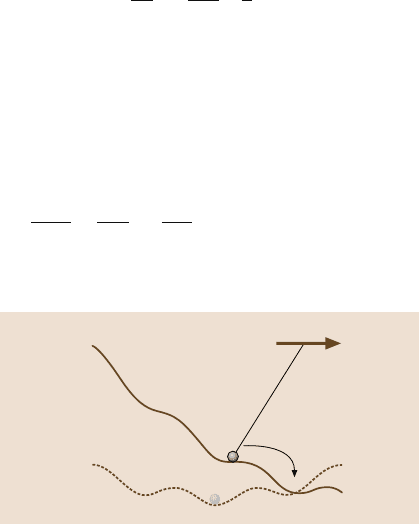
11 Friction and Wear on the Atomic Scale 565
11.2 The Tomlinson Model
In Sect. 11.3, we show that the FFM can reveal friction forces down to the atomic
scale, which are characterized by a typical sawtooth pattern. This phenomenon can
be seen as a consequence of a stick-slip mechanism, first discussed by Tomlinson in
1929 [23].
11.2.1 One-Dimensional Tomlinson Model
In the Tomlinson model, the motion of the tip is influenced by both the interaction
with the atomic lattice of the surface and the elastic deformations of the cantilever.
The shape of the tip–surface potential, V(r), depends on several factors, such as the
chemical composition of the materials in contact and the atomic arrangement at the
tip end. For the sake of simplicity, we will start the analysis in the one-dimensional
case considering a sinusoidal profile with an atomic lattice periodicity a and a peak-
to-peak amplitude E
0
. In Sect. 11.5, we will show howthe elasticityof the cantilever
and the contact area can be described in a unique framework by introducing an ef-
fective lateral spring constant, k
eff
. If the cantilever moves with a constant velocity v
along the x-direction, the total energy of the system is
E
tot
(x, t) = −
E
0
2
cos
2πx
a
+
1
2
k
eff
(vt−x)
2
. (11.8)
Figure 11.8 shows the energy profile E
tot
(x, t)attwodifferent instants. When
t = 0, the tip is localized in the absolute minimum of E
tot
. This minimum increases
with time due to the cantilever motion, until the tip position becomes unstable when
t = t
∗
.
At a given time t, the position of the tip can be determined by equating the first
derivative of E
tot
(x, t) with respect to x to zero:
∂E
tot
∂x
=
πE
0
a
sin
2πx
a
−k
eff
(vt−x) = 0 . (11.9)
t = t*
t = 0
v
Fig. 11.8. Energy profile
experienced by the FFM tip
(black circle)att = 0(dotted
line)andt = t
∗
(continuous
line)
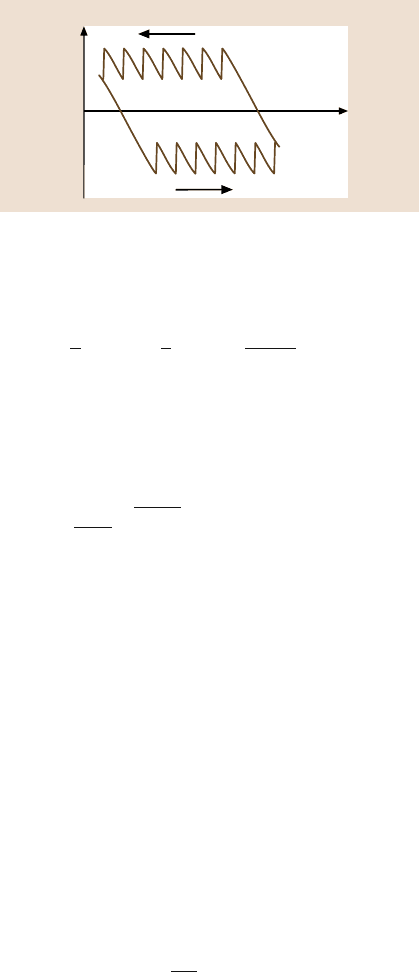
566 Enrico Gnecco et al.
X
F
L
Fig. 11.9. Friction loop ob-
tained by scanning back and
forth in the 1-D Tomlinson
model. The effective spring
constant k
eff
is the slope of
the sticking part of the loop
(if γ 1)
The critical position x
∗
correspondingto t = t
∗
is determined by equating the second
derivative ∂
2
E
tot
(x, t)/∂x
2
to zero, which gives
x
∗
=
a
4
arccos
−
1
γ
,γ=
2π
2
E
0
k
eff
a
2
. (11.10)
The coefficient γ compares the strength of the interaction between the tip and the
surface with the stiffness of the system. When t = t
∗
the tip suddenly jumps into
the next minimum of the potential profile. The lateral force F
∗
= k
eff
(vt− x
∗
)that
induces the jump can be evaluated from (11.9) and (11.10):
F
∗
=
k
eff
a
2π
!
γ
2
−1 . (11.11)
Thus the stick-slip is observedonly if γ>1: when the system is not too stiff or when
the tip–surface interaction is strong enough. Figure 11.9 shows the lateral force F
L
as a function of the cantilever position, X. When the cantilever is moved to the
right, the lower part of the curve in Fig. 11.9 is obtained. If, at a certain point, the
cantilever’s direction of motion is suddenly inverted,the force has the profileshown
in the upper part of the curve. The area of the friction loop obtained by scanning
back and forth gives the total energy dissipated.
On the other hand, when γ<1, the stick-slip is suppressed. The tip slides in
a continuousway on the surfaceand the lateral force oscillates between negativeand
positive values. Instabilities vanish in this regime, which leads to the disappearance
of lateral force hysteresis and correspondingly negligible dissipation losses.
11.2.2 Two-Dimensional Tomlinson Model
In two dimensions, the energy of our system is given by
E
tot
(r,t) = U(r)+
k
eff
2
(vt−r)
2
, (11.12)
where r ≡ (x, y)andv is arbitrarily oriented on the surface (note that v dr/ dt!).
Figure 11.10 shows the total energy corresponding to a periodic potential of the

11 Friction and Wear on the Atomic Scale 567
Fig. 11.10. Energy landscape
experienced by the FFM tip
in 2-D
form
U(x, y,t) = −
E
0
2
cos
2πx
a
+ cos
2πy
a
+ E
1
cos
2πx
a
cos
2πy
a
. (11.13)
The equilibrium condition becomes
∇E
tot
(r,t) = ∇U(r)+ k
eff
(r−vt) = 0 . (11.14)
The stability of the equilibrium can be described by introducing the Hessian matrix
H =
⎛
⎜
⎜
⎜
⎜
⎜
⎜
⎜
⎜
⎜
⎜
⎜
⎜
⎜
⎝
∂
2
U
∂x
2
+ k
eff
∂
2
U
∂x∂y
∂
2
U
∂y∂x
∂
2
U
∂y
2
+ k
eff
⎞
⎟
⎟
⎟
⎟
⎟
⎟
⎟
⎟
⎟
⎟
⎟
⎟
⎟
⎠
. (11.15)
When both eigenvalues λ
1,2
of the Hessian are positive, the position of the tip is
stable. Figure 11.11 shows these regions for a potential of the form (11.13). The tip
3.0
2.5
2.0
1.5
1.0
0.5
0.0
0.0 0.5 1.0 1.5 2.0 2.5 3.0
+ +
+ +
+ +
– –
– –
+ +
+ +
+ +
– –
– –
+ +
+ +
+ +
Fig. 11.11. Regions on the tip
plane labeled according to the
signs of the eigenvalues of the
Hessian matrix. (After [24])
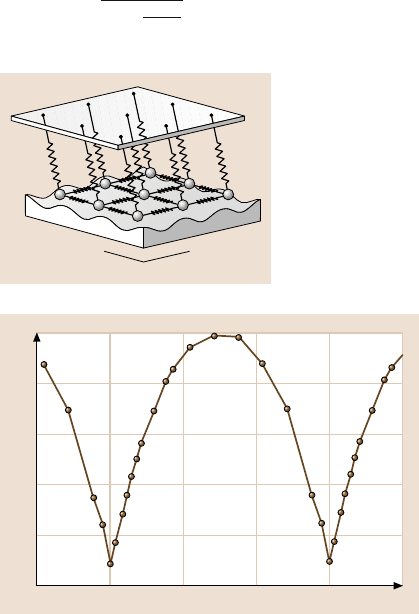
568 Enrico Gnecco et al.
follows the cantilever adiabatically as long as it remains in the (++)-region. When
the tip is dragged to the border of the region, it suddenly jumps into the next (++)-
region. A comparison between a theoretical friction map deduced from the 2-D
Tomlinson model and an experimental map acquired by UHV-FFM is given in the
next section.
11.2.3 Friction Between Atomically Flat Surfaces
So far we have implicitly assumed that the tip is terminated by only one atom.
It is also instructive to consider the case of a periodic surface sliding on another
periodic surface. In the Frenkel–Kontorova–Tomlinson (FKT) model, the atoms of
one surface are harmonically coupled with their nearest neighbors. We will restrict
ourselves to the case of quadratic symmetries, with lattice constants a
1
and a
2
for
the upper and lower surfaces, respectively (Fig. 11.12). In this context, the role
of commensurability is essential. It is well known that any real number z can be
represented as a continued fraction:
z = N
0
+
1
N
1
+
1
N
2
+...
. (11.16)
11
Fig. 11.12. The FKT model in 2-D. (After [25])
1.3
1.2
1.1
1.0
0.9
0.8
– 30 1209060300
Fig. 11.13. Friction as a func-
tion of the sliding angle ϕ
in the 2-D FKT model. (Af-
ter [25])
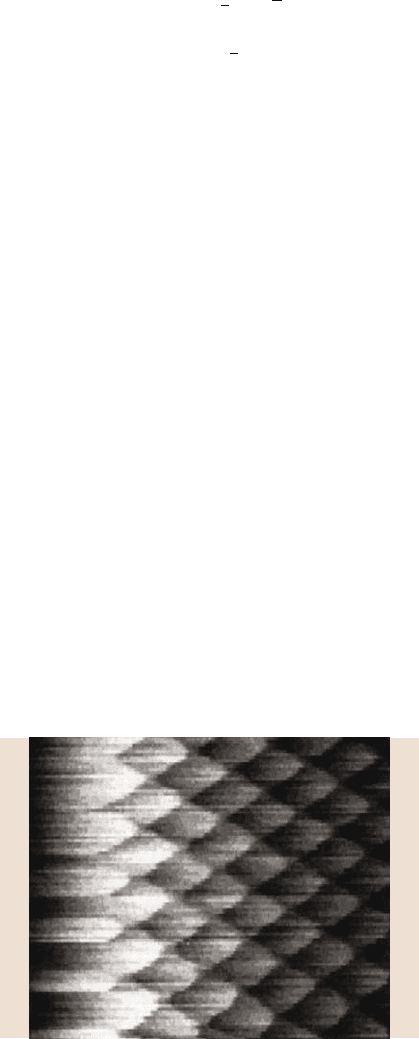
11 Friction and Wear on the Atomic Scale 569
The sequence that converges most slowly is obtained when all N
i
= 1, which corre-
sponds to the golden mean
z = (
√
5−1)/2. In 1-D, Weiss and Elmer predicted that
friction should decrease with decreasing commensurability, the minimum friction
being reached when a
1
/a
2
= z [26].
In 2-D, Gyalog and Thomas studied the case a
1
= a
2
, with a misalignment
between the two lattices given by an angle θ [25]. When the sliding direction
changes, friction also varies from a minimumvalue (corresponding to the sliding
angle ϕ = θ/2) to a maximum value (which is reached when ϕ = θ/2 + π/4; see
Fig. 11.13). The misfit angle θ is related to the commensurability. Since the misfit
angles that give rise to commensurate structure forma dense subset, the dependence
of friction on θ should be discontinuous. The numerical simulations performed by
Gyalog are in agreement with this conclusion.
11.3 Friction Experiments on the Atomic Scale
Figure 11.14 shows the first atomic-scale friction map, as observed by Mate. The
periodicity of the lateral force is the same as that of the atomic lattice of graphite.
The series of friction loops in Fig. 11.15 reveals the stick-slip effect discussed in
the previous section. The applied loads are in the range of tens of µN. According
to the continuum models discussed in Sect. 11.5, these values correspond to contact
diameters of 100 nm. A possible explanation for the atomic features observed at
such high loads is that graphite flakes may have detached from the surface and
adhered to the tip [27]. Another explanation is that the contact between tip and
surface consisted of few nm-scale asperities andthat the corrugationwas notentirely
averaged out while sliding. The load dependence of friction as found by Mate is
rather linear, with a small friction coefficient μ = 0.01 (Fig. 11.16).
The UHV environment reduces the influence of contaminants on the surface
and leads to more precise and reproducible results. Meyer et al. [28] obtained
a series of interesting results on ionic crystals using the UHV-FFM apparatus de-
Fig. 11.14. First atomic
friction map acquired on
graphite with a normal force
F
N
= 56 µN. Frame size:
2 nm. (After [1])
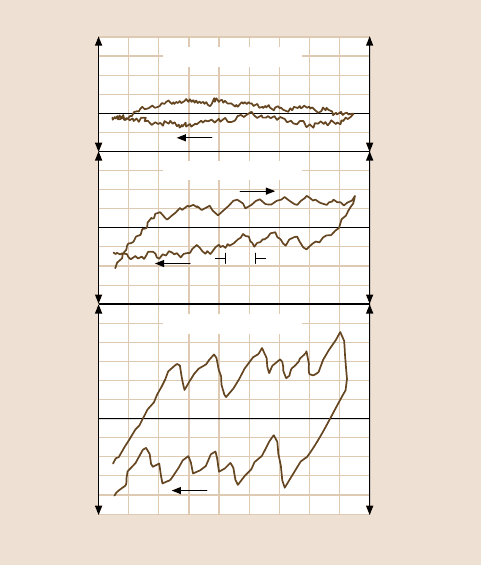
570 Enrico Gnecco et al.
5.0
0.0
– 5.0
5.0
0.0
– 5.0
10.0
5.0
0.0
– 5.0
– 10.0
Wire spring constant = 2,500 N/m
2.0
0.0
– 2.0
2.0
0.0
– 2.0
4.0
2.0
0.0
– 2.0
– 4.0
0.0 5.0 10.0 15.0 20.0
a)
b)
c)
Load = 7.5 u10
–6
N
Load = 2.5 u10
–5
N
Load = 5.6 u10
–5
N
u Sample position (Å)
25 (Å)
C
Wire
deflection (Å)
Frictional
Force
(10
–7
N)
Fig. 11.15. Frictionloops on graphite acquired with (a) F
N
= 7.5 µN, (b)24µNand(c)75µN.
(After [1])
scribed in Sect. 11.1.4. By applying subnanonewton loads to a NaCl surface, So-
coliuc et al. observed the transition from stick-slip to continuous sliding discussed
in Sect. 11.2.1 [29]. In Fig. 11.17, a friction map recorded on KBr(100) is com-
pared with a theoretical map obtained with the 2-D Tomlinson model. The perio-
dicity a = 0.47nm corresponds to the spacing between equally charged ions. No
individual defects were observed. One possible reason is that the contact realized
by the FFM tip is always formed by many atoms, which superimpose and average
their effects. Molecular dynamics (MD) calculations (Sect. 11.7) show that even
single-atom contact may cause rather large stresses in the sample, which lead to the
motion of defects far away from the contact area. In a rather picturesque analogy,
we can say that “defects behave like dolphins that swim away in front of an ocean
cruiser” [28].
Lüthi et al. [30] even detected atomic-scale friction on a reconstructed Si(111)
7×7 surface. However, uncoated Si tips and tips coated with Pt, Au, Ag, Cr and
Pt/C damaged the sample irreversibly, and the observation of atomic features was
achieved only after coating the tips with polytetrafluoroethylene(PTFE), which has
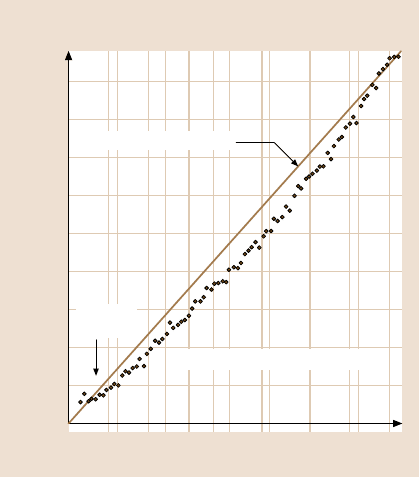
11 Friction and Wear on the Atomic Scale 571
z Sample position (Å)
Average
friction
(10
–8
N)
20.0
15.0
10.0
5.0
0.0
0 200 400 600 800 1,000 1,200 1,400
Load (10
–6
N)
0.0 20.05.0 10.0 15.0
Wire spring constant 155 N/m
Friction = 0.012 u Load
Onset of
stick-slip
Fig. 11.16. Load dependence
of friction on graphite.
(After [1])
lubricant properties and does not react with the dangling bonds of Si(111)7× 7
(Fig. 11.18).
Recently friction was even resolved on the atomic scale on metallic surfaces in
UHV [31]. In Fig. 11.19a a reproducible stick-slip process on Cu(111) is shown.
Sliding on the (100) surface of copper produced irregular patterns, although atomic
features were recognized even in this case (Fig. 11.19b). Molecular dynamics sug-
gests that wear should occur more easily on the Cu(100) surface than on the close-
packed Cu(111) (Sect. 11.7). This conclusion was achieved by adopting copper tips
in computer simulations. The assumption that the FFM tip used in the experiments
was covered by copper is supportedby current measurementsperformed at the same
time.
Atomic stick-slip on diamond was observed by Germann et al. with an apposite
diamond tip prepared by chemical vapor deposition [33] and, a few years later, by
van der Oetelaar et al. [34] with standard silicon tips. The values of friction vary
dramatically depending on the presence or absence of hydrogen on the surface.
Fujisawa et al. [36] measured friction on mica and on MoS
2
with a 2-D FFM
apparatus that could also reveal forces perpendicular to the scan direction. The fea-
tures in Fig. 11.20 correspond to a zigzag tip walk, which is predicted by the 2-D
Tomlinson model [37]. Two-dimensional stick-slip on NaF was detected with nor-
mal forces below 14nN, whereas loads of up to 10µN could be applied to layered
materials. The contact between tip and NaF was thus formed by one or a few atoms.
A zigzag walk on mica was also observed by Kawakatsu et al. using an original 2-D
FFM with two laser beams and two quadrant photodetectors [38].
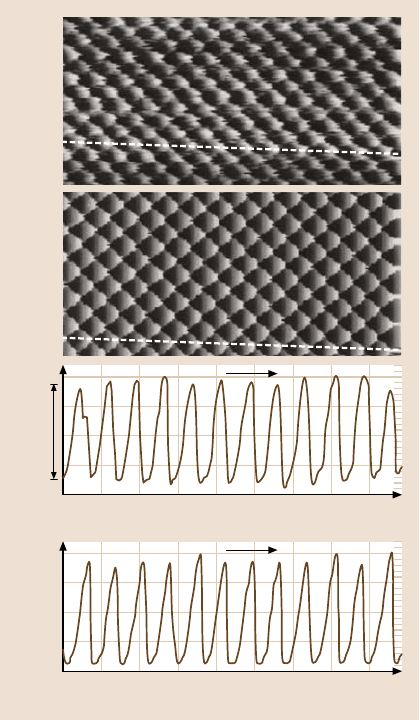
572 Enrico Gnecco et al.
Distance (nm)
a)
b)
Lateral
force
(nN)
3.0
Distance (nm)
012345678
012345678
Lateral
force
(nN)
(a. u.)
Fig. 11.17. (a) Measured and
(b) theoretical friction map
on KBr(100). (After [32])
11.3.1 Anisotropy of Friction
The importance of the misfit angle in the reciprocal sliding of two flat surfaces was
first observedexperimentally by Hirano et al. in the contact of two mica sheets [39].
The friction increased when the two surfaces formed commensurate structures, in
agreement with the discussion in Sect. 11.2.3. In more recent measurements with
a monocrystalline tungsten tip on Si(001), Hirano et al. observed superlubricity in
the incommensurate case [40].
Overney et al. [44] studied the effects of friction anisotropy on a bilayer lipid
film. In this case, different molecular alignments resulted in significant variations in
the friction. Other measurements of friction anisotropy on single crystals of stearic
acid were reported by Takano and Fujihira [45].An impressive confirmation of this
effect recently came from a dedicated force microscope developed by Frenken and
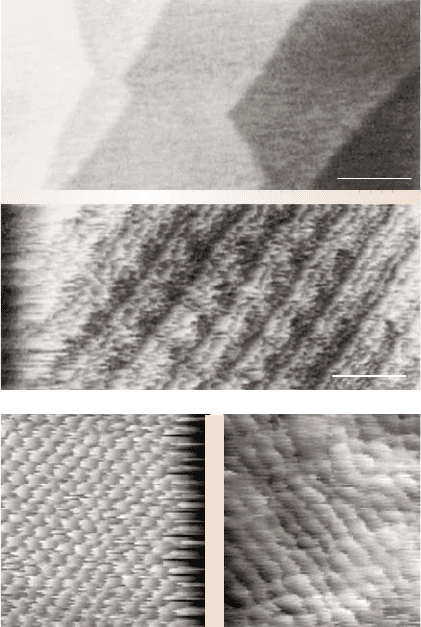
11 Friction and Wear on the Atomic Scale 573
100 nm
5 nm
a)
b)
Fig. 11.18. (a) Topography
and (b) friction image of
Si(111)7×7 measured with
a PTFE-coated Si tip. (After
[30])
a) b)
Fig. 11.19. Friction images of
(a) Cu(111) and (b) Cu(100).
Frame size: 3 nm. (After [35])
coworkers, the Tribolever, which allows quantitative tracking of the scanning force
in three dimensions [46]. With this instrument, a flake from a graphite surface was
picked up and the lateral forces between the flake and the surface were measured
at different angles of rotation. Stick-slip and energy dissipation were only clearly
revealed at rotation angles of 0
◦
and 60
◦
, when the two lattices are in registry.
Liley et al. [41] observed flower-shaped islands of a lipid monolayer on mica,
which consisted of domains with different molecular orientations (Fig. 11.21). The
angular dependence of friction reflects the tilt direction of the alkyl chains of the
monolayer, as revealed by other techniques.
Lüthi et al. [42] used the FFM tip to move C
60
islands, which slide on sodium
chloride in UHV without disruption (Fig. 11.22). In this experimentthe friction was
found to be independent of the sliding direction. This was not the case in other ex-
periments performed by Sheehan and Lieber, who observed that the misfit angle is
relevant when MoO
3
islands are dragged on the MoS
2
surface [47]. In these exper-
iments, sliding was possible only along low index directions. The weak orientation
dependence found by Lüthi et al. [42] is probably due to the large mismatch of C
60
on NaCl.
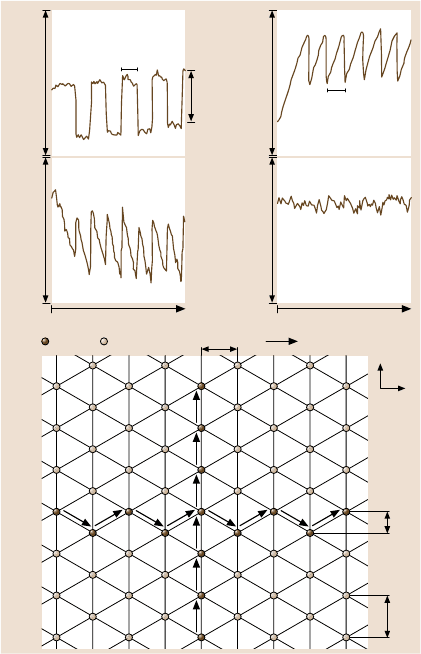
574 Enrico Gnecco et al.
f
x
4.6 Å
a)
5.8 Å
2.74 Å
f
y
5.2 Å
25 Å
f
x
9.2 Å
b)
3.16 Å
f
y
5.2 Å
25 Å
c)
2.74 Å
3.16 Å
stick point slip motion
1.56 Å
x
y
Fig. 11.20. (a) Friction force
on MoS
2
acquired by scan-
ning along the cantilever and
(b) across the cantilever.
(c) Motion of the tip on the
sample. (After [36])
A recent example of friction anisotropy is related to carbon nanotubes. Falvo
et al. [43] manipulated nanotubes on graphite using a FFM tip (Fig. 11.23). A dra-
maticincrease inthe lateral force wasfound indirectionscorrespondingto commen-
suratecontact. Atthe same time,the nanotubemotionchanged fromsliding/rotating
to stick-roll.
11.4 Thermal Effects on Atomic Friction
Although the Tomlinson model gives a good interpretation of the basic mechanism
of the atomic stick-slip discussed in Sect. 11.2, it cannot explain some minor fea-
tures observed in the atomic friction. For example, Fig. 11.24 shows a friction loop
acquired on NaCl(100). The peaks in the sawtooth profile have different heights,
which is in contrast to the result in Fig. 11.9. Another effect is observed if the
scan velocity v is varied: the mean friction force increases with the logarithm of v
